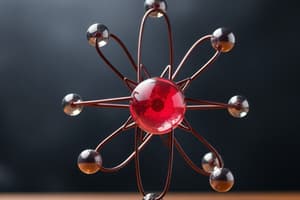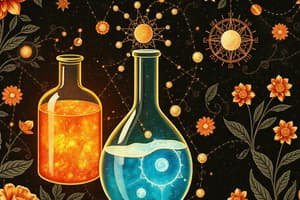Podcast
Questions and Answers
What is the main study focus of Organic Chemistry?
What is the main study focus of Organic Chemistry?
- Study of chemical processes in living organisms
- Study of inorganic compounds
- Study of the physical principles governing chemical systems
- Study of carbon-containing compounds (correct)
Plasma is a state of matter that has a fixed shape and volume.
Plasma is a state of matter that has a fixed shape and volume.
False (B)
What are the three subatomic particles that make up an atom?
What are the three subatomic particles that make up an atom?
Protons, Neutrons, Electrons
In a chemical reaction, the __________ states that mass is neither created nor destroyed.
In a chemical reaction, the __________ states that mass is neither created nor destroyed.
Match the following types of chemical bonds with their descriptions:
Match the following types of chemical bonds with their descriptions:
Which of the following is not a type of chemical reaction?
Which of the following is not a type of chemical reaction?
Acids have a pH greater than 7.
Acids have a pH greater than 7.
The elements in the same vertical column of the Periodic Table are known as __________.
The elements in the same vertical column of the Periodic Table are known as __________.
Flashcards are hidden until you start studying
Study Notes
Basic Concepts of Chemistry
- Definition: Chemistry is the study of matter, its properties, composition, and changes it undergoes during chemical reactions.
- Branches:
- Organic Chemistry: Study of carbon-containing compounds.
- Inorganic Chemistry: Study of inorganic compounds, metals, and minerals.
- Physical Chemistry: Study of the physical principles governing chemical systems.
- Analytical Chemistry: Techniques and methods to analyze substances' composition.
- Biochemistry: Study of chemical processes in living organisms.
States of Matter
- Solid: Fixed shape and volume, particles closely packed.
- Liquid: Fixed volume but takes shape of the container, particles are close but can move.
- Gas: No fixed shape or volume, particles are far apart and move freely.
- Plasma: Ionized gas with free electrons, found in stars.
Atomic Structure
- Atoms: Basic unit of matter, consist of:
- Protons: Positively charged particles in the nucleus.
- Neutrons: Neutral particles in the nucleus.
- Electrons: Negatively charged particles orbiting the nucleus.
- Atomic Number: Number of protons in an atom's nucleus; defines the element.
- Mass Number: Total number of protons and neutrons in an atom.
Chemical Bonds
- Ionic Bonds: Formed by the transfer of electrons from one atom to another, creating charged ions.
- Covalent Bonds: Formed by sharing electrons between atoms.
- Metallic Bonds: Involve a sea of shared electrons among metal atoms.
Chemical Reactions
- Types:
- Synthesis: A + B → AB
- Decomposition: AB → A + B
- Single Replacement: A + BC → AC + B
- Double Replacement: AB + CD → AD + CB
- Combustion: Hydrocarbon + O₂ → CO₂ + H₂O
- Law of Conservation of Mass: Mass is neither created nor destroyed in a chemical reaction.
Acids and Bases
- Acids: Substances that donate protons (H⁺ ions) in a reaction; pH < 7.
- Bases: Substances that accept protons or donate hydroxide ions (OH⁻); pH > 7.
- pH Scale: Measures acidity or alkalinity, ranges from 0 (acidic) to 14 (basic).
Periodic Table
- Organization: Elements are arranged by increasing atomic number and grouped by similar properties.
- Groups: Vertical columns that share similar chemical properties (e.g., alkali metals, halogens).
- Periods: Horizontal rows corresponding to energy levels of electrons.
Important Concepts
- Moles: A unit that measures the amount of substance; 1 mole = 6.022 x 10²³ particles (Avogadro's number).
- Stoichiometry: Calculation of reactants and products in chemical reactions based on balanced equations.
- Thermochemistry: Study of heat changes during chemical reactions.
Key Terms
- Catalyst: A substance that speeds up a chemical reaction without being consumed.
- Equilibrium: A state where the forward and reverse reactions occur at equal rates.
- Redox Reactions: Reactions involving the transfer of electrons, involving oxidation and reduction processes.
Basic Concepts of Chemistry
- Chemistry is the study of matter, its properties, composition, and chemical reaction changes.
- Organic Chemistry focuses on carbon-containing compounds.
- Inorganic Chemistry deals with inorganic compounds, including metals and minerals.
- Physical Chemistry examines physical principles that influence chemical systems.
- Analytical Chemistry involves techniques to analyze substance composition.
- Biochemistry studies chemical processes within living organisms.
States of Matter
- Solids have a fixed shape and volume with closely packed particles.
- Liquids maintain a fixed volume but adopt the shape of their container; particles are close yet mobile.
- Gases lack fixed shape or volume, with particles far apart and in constant motion.
- Plasma is an ionized state of matter with free electrons, commonly found in stars.
Atomic Structure
- Atoms are the fundamental units of matter, consisting of protons, neutrons, and electrons.
- Protons have a positive charge and are found in the nucleus.
- Neutrons are neutral particles also located in the nucleus.
- Electrons are negatively charged and orbit the nucleus.
- The atomic number indicates the number of protons in an atom and defines the element.
- The mass number is the total count of protons and neutrons in an atom.
Chemical Bonds
- Ionic Bonds are formed through electron transfer between atoms, producing charged ions.
- Covalent Bonds result from the sharing of electrons between atoms.
- Metallic Bonds involve a shared "sea" of electrons among metal atoms.
Chemical Reactions
- Types of chemical reactions include:
- Synthesis: A + B → AB
- Decomposition: AB → A + B
- Single Replacement: A + BC → AC + B
- Double Replacement: AB + CD → AD + CB
- Combustion: Hydrocarbon + O₂ → CO₂ + H₂O
- The Law of Conservation of Mass states that mass remains unchanged during a chemical reaction.
Acids and Bases
- Acids donate protons (H⁺ ions) and have a pH less than 7.
- Bases accept protons or donate hydroxide ions (OH⁻), and have a pH greater than 7.
- The pH Scale ranges from 0 (acidic) to 14 (basic), measuring acidity and alkalinity.
Periodic Table
- Elements are arranged by increasing atomic number and grouped by similar properties.
- Groups are vertical columns of elements with shared chemical characteristics (e.g., alkali metals, halogens).
- Periods are horizontal rows that indicate electron energy levels.
Important Concepts
- A mole measures substance quantity; 1 mole equals 6.022 x 10²³ particles (Avogadro's number).
- Stoichiometry involves calculating reactants and products in a reaction based on balanced equations.
- Thermochemistry studies heat changes during chemical reactions.
Key Terms
- A Catalyst accelerates a chemical reaction without being consumed in the process.
- Equilibrium is achieved when forward and reverse reactions occur at the same rate.
- Redox Reactions involve electron transfer, focusing on oxidation and reduction processes.
Studying That Suits You
Use AI to generate personalized quizzes and flashcards to suit your learning preferences.




